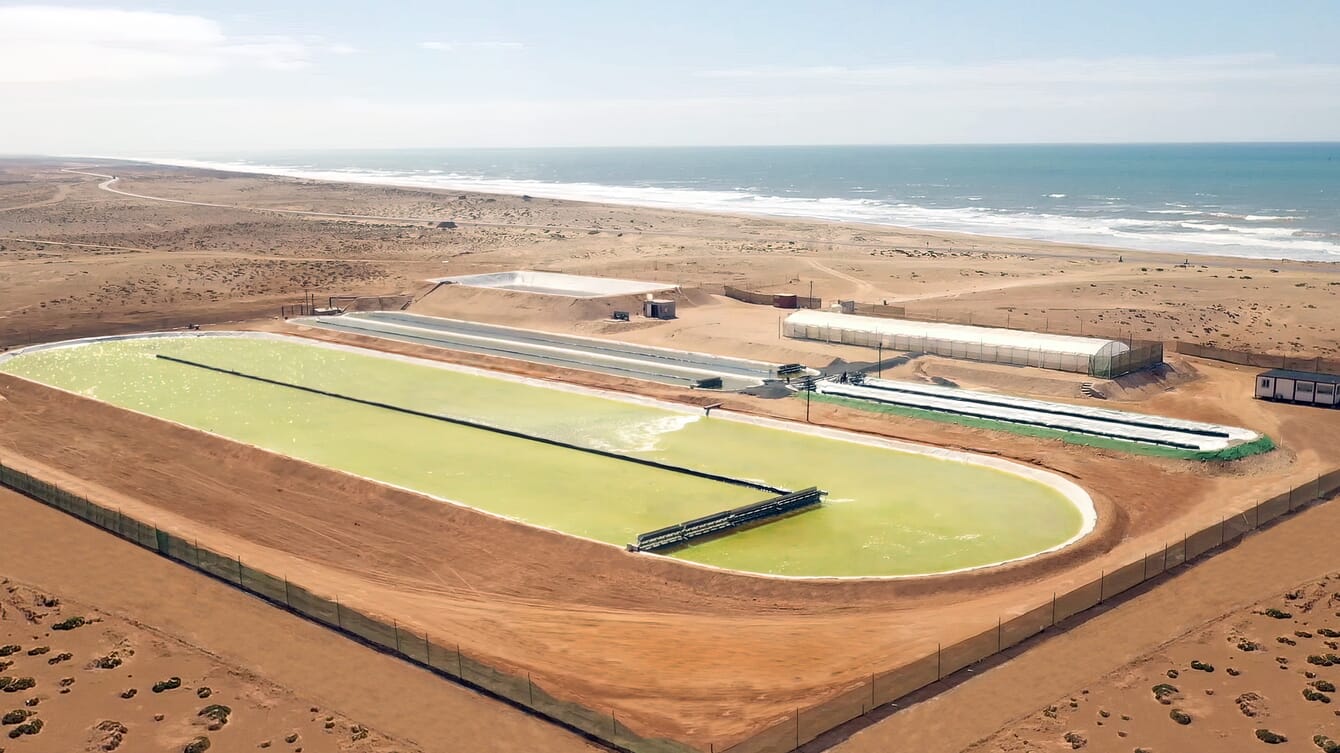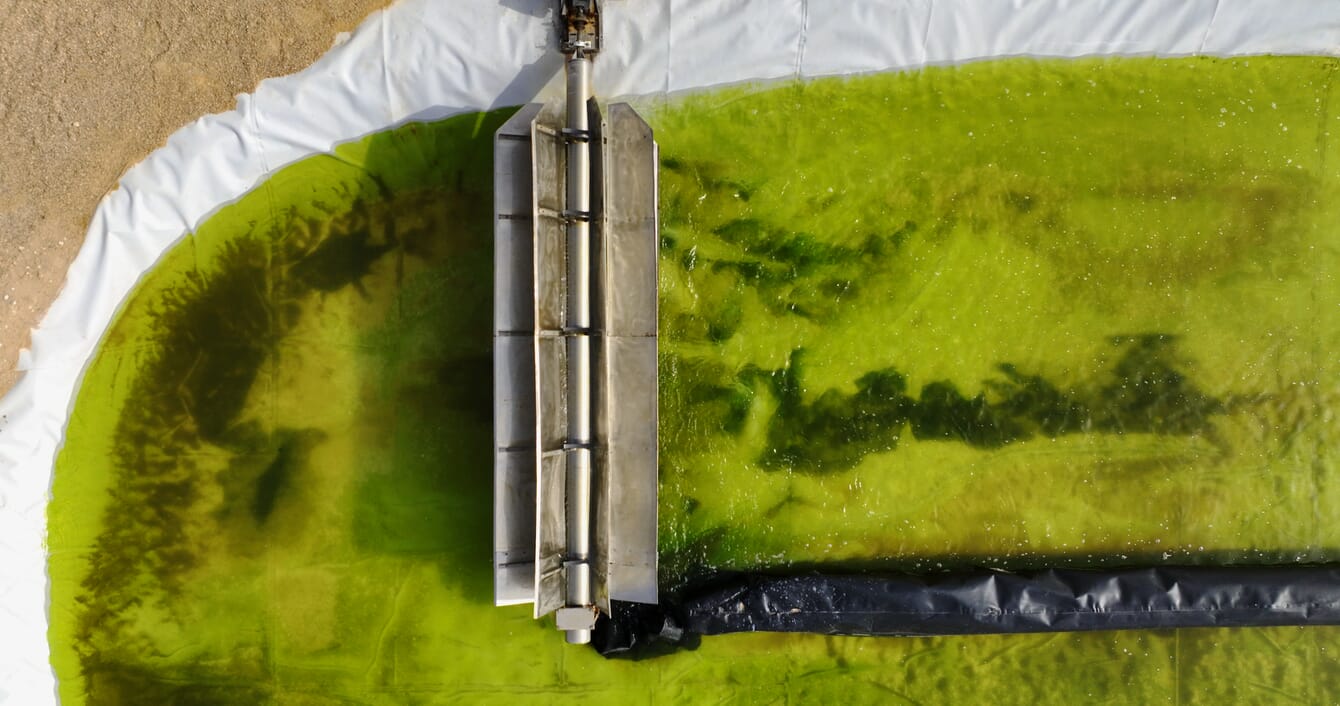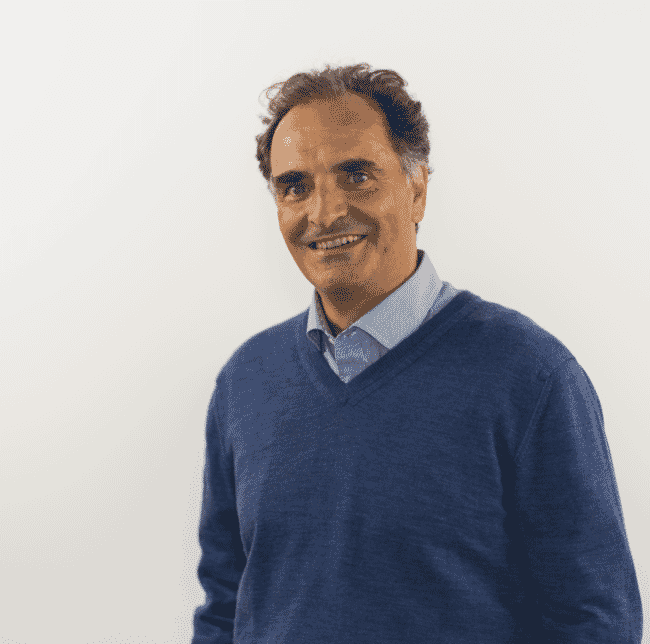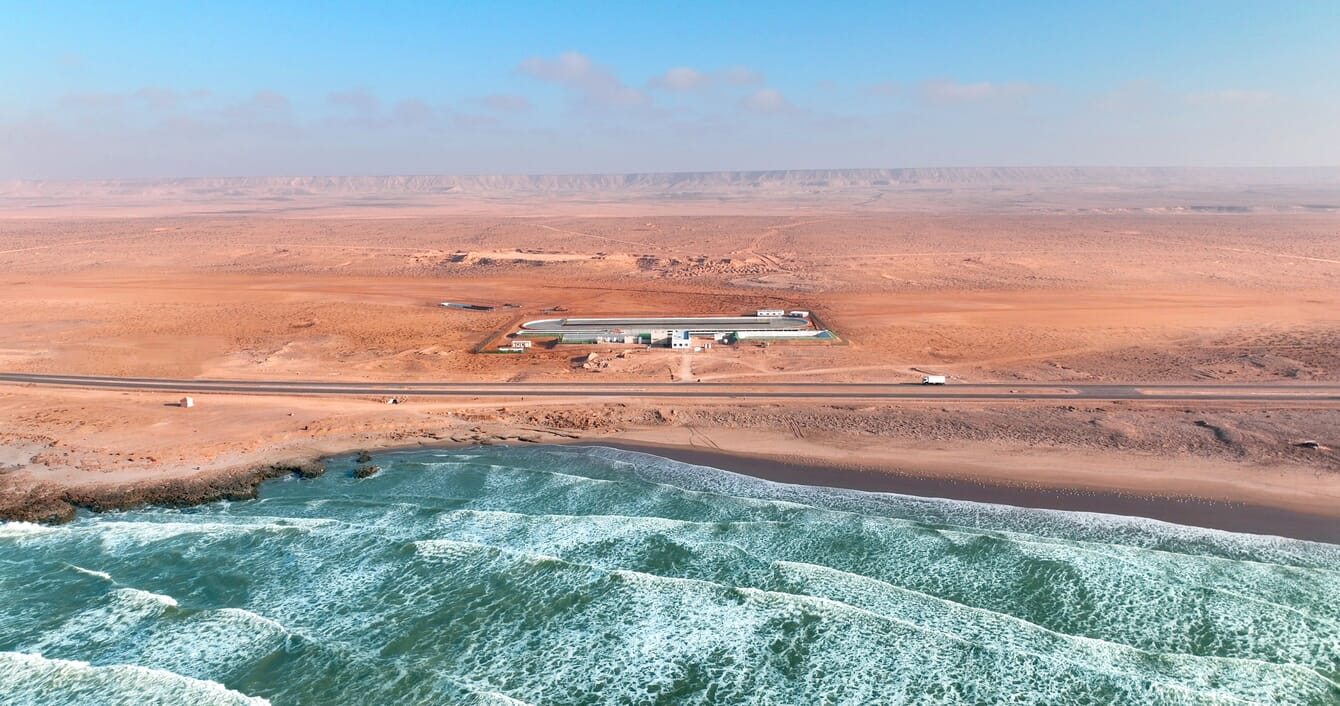
© Brilliant Planet
In a nutshell, the business revolves around filling ponds in coastal deserts with nutrient-rich seawater and then seeding them with local algae. While Brilliant Planet* initially aimed to convert these algae into aquafeed ingredients, they have since pivoted to drying and burying them, as a form of carbon capture.
It’s a truly unique idea, but the startup’s quietly charismatic founder, Raffael Jovine, makes a strong case for its potential, supported by research gleaned from eight years of field trials in Morocco, Oman and South Africa.
“We’re in a very different place than we were before – we knew that the concept would work in terms of the volumes, but as well as getting much better on the technical and engineering side we now know more from a social and environmental point of view. And, having done a thorough life cycle analysis, we have identified further hotspots for improvement before we scale up,” Jovine explains.
The evolution of a unique concept
A molecular biochemist and biophysicist by training, with a depth of experience in biological engineering – gained at Yale, MIT, UCSB and Woods Hole – Jovine’s path to founding a startup was inspired by field trip to one of the most remote regions of the ocean.
“I ended up at Woods Hole Oceanographic looking at the environmental triggers behind harmful algal blooms and why some organisms respond more than others. At the time the goal was to stop blooms and reduce them,” he recalls.
However, it also made him consider that doing the opposite – creating algal blooms – could potentially help provide a solution to climate change.
“When on assignment in the Central Pacific Gyre, I realised that the organisms in the middle of the gyre, despite the lack of nutrients, were photosynthetically much more effective than anything I could engineer in the lab,” he recalls.
The discovery inspired Jovine to formulate a concept that was good enough to reach the longlist for the – later-to-be-cancelled – Virgin Earth Challenge, so he decided to patent it, in 2008. Since then the idea has evolved considerably.
“There was no carbon market at the time, so we looked at using the algae for livestock and aquaculture feed. We did lots of feed trials and got fantastic results – the algae were rich in protein and omega-3s. But it was always going to take a long time to fit into the big feed producers’ schemes: to get to a size where we could fill a silo at an attractive price point. However, the carbon market has since developed, and we realised that if we cut out a lot of the post-harvest processing needed to get the algae into fish feed, we could be low enough cost for carbon,” he explains.

The startup plans to bury the resulting biomass as a means of carbon capture and sequestration © Brilliant Planet
According to Jovine, this has allowed them to concentrate almost purely on the production – rather than processing – of the algae, and they’ve identified areas for further improvements.
One such area relates to finding the most efficient species of algae, following extensive trials in their London lab.
“For biofuels the cells divide once every 18 to 21 days, depending on what scheme you use, but our cells divide more than once per day and there are some organisms that divide as much as five-and-a-half times a day, so there’s still room for improvement. We like large organisms that are easy to harvest and are fast growing,” reflects Jovine.
While they plan to concentrate on producing a single species per location, they are considering changing their species according to the season – for example, using one for the summer and another for the winter. However, they are not able to use genetically engineered algae, as they farm in open systems.
“Whatever we grow will escape into the environment, so it’s very important that we work with natural, local organisms the way they are,” he emphasises.
Pond management is another area where progress is being made.
“We can run our ponds a little bit warmer than the local surface seawater – in Morocco our ponds are two degrees hotter than the sea, which has a significant productivity boost,” notes Jovine.
Equally, they have discovered that the shape of the ponds and the rate of water intake can significantly impact productivity. And the team have also been delving deep into the photo and nutrient physiologies of algae.
“We look at the fundamental cell physiology – what is it that’s limiting the growth – and we’re uniquely strong on measuring instant growth. At any moment I can tell you exactly how fast the algae are growing – and so we can measure the impact of, for example, a cloud passing over the pond,” he explains.
“As for the nutrient physiology, even though we work in areas with nutrient-rich sea water there’s never enough nutrients around, never enough carbon around. But we are much better than nature, because we manipulate the system – by optimising the conditions in the ponds we’re taking as much as 10 times more CO2 out of the seawater than would happen with a natural algal bloom offshore,” he adds.
While Brilliant Planet do add nutrients to the ponds, this is done carefully, and on a seasonal basis. The main source of their nutrients currently comes from a local phosphate facility, which Jovine says has a “very green” method for producing phosphate or ammonia.
“What we don’t want to do is feed competitor organisms or dump nutrients that will then create eutrophication offshore. If you look at normal algal production recipes you add 880 micromoles of nitrate, but we only add around 30 micromoles. It’s very targeted,” he explains.
Another breakthrough highlighted by Jovine is the development of a model, which takes into account 54 parameters and allows the company to predict the growth rate of the algae on any given day, allowing them to adjust some of the technologies, such as the paddlewheels in their ponds, to optimse growth according to the conditions.
He is also confident that they now have sufficient engineering expertise in place for a dramatic scale up.
“We’re thinking about very large scale engineering and our chief engineer used to be the lead engineer for Mott MacDonald, who designed the Thames Tideway – an 86 km tunnel that runs underneath the Thames and catches 85 percent of London’s runoff,” he notes.
Potential locations
While Jovine says that the government of Morocco has been very supportive, the project has also been making waves further afield and has attracted the attention of the UN, which has made it one of their blue belt initiative reference projects. Brilliant Planet are now looking to expand into a range of coastal desert locations that are close to the world’s strongest nutrient upwelling systems – including Chile, Peru and Namibia – essentially making it a platform technology, according to Jovine.
While the ocean currents in these areas provide a steady source of nutrient-rich water, the startup is also determined that its facilities are only located on land that is otherwise largely unproductive and yet is blessed with high levels of sunlight – providing a win-win-win for resource efficiency.
“We take seawater from below the mixed layer depth, and use it to fill ponds on empty desert land where you couldn’t grow a blade of grass. It’s all about the additionality: it’s new primary production that wouldn’t have happened otherwise,” Jovine explains.

Community support
As well as the environmental positives, Brilliant Planet also has a strong socio-economic agenda.
“We’re working with very humble communities at the edge of the desert and provide a lot of training – from language skills and lab work to engineering maintenance and IT skills. We’ve also learned from the locals’ ‘desert solutions’ – ways to operate in such a harsh environment,” notes Jovine.
The company already employs close to 40 people, making it the largest employer in a county that’s roughly the size of Wales, but has a population of only 2,200 As a result, its presence in Morocco has been well received, by offering highly skilled jobs in an area that otherwise offers few opportunities for the bright and ambitious, especially women.
“We have a strong female representation on the team. The young men who work for us would typically be labourers in Tarfaya [the nearest town, 120 km away] if they stayed in the region, but now they can stay here and work for us in skilled trades, as electricians and engineers,” he explains.
According to Jovine, the facility also has positive environmental impacts in its immediate locality, as the ponds reflect more sunlight than the desert while evaporation from them helps to cool the air. Meanwhile, if scaled up, the site could rejuvenate local bivalve farms by discharging de-acidified water back into the ocean, improving growing conditions.
“By the time we reach 100s of hectares of ponds it will be significant enough to be able to trace the impact we are having on biodiversity – we’re just starting on baseline data collection now, but our assumption is that our de-acidification will actually have a productivity enhancing quality,” Jovine explains.
Neither fish nor fowl
The visionary nature of Brilliant Planet’s concept is something of a mixed blessing, according to Jovine, as it doesn’t conform with better documented carbon capture technologies.
“We’re not an ocean-based solution in the way that people think of ocean alkalinity enhancement, or artificial upwelling. And at the same time, we’re on land but we’re not growing conventional woody, ligno-cellulose biomass or storing it in the same way. We’re a hybrid, which means we’ve had to do our own life cycle analysis, and develop our own monitoring tools that account for our environmental impacts as well as our carbon removals,” he explains.
“We store things in a different way – we essentially mummify biomass, which means it’s super-salty, super dry and quite acidic. We can store 100 percent of the carbon that’s embedded in the biomass and it’s super stable – we measure it every day and it has zero emissions – but it requires a whole other level of authentication,” he adds.

The only drawback is the high energy nature of the ocean, which means that the water intake pipe for the farm needs to be extremely robust © Brilliant Planet
As a result, he argues that investors need to view the opportunity with a fresh perspective.
“Think of us as like a utility company: we provide a community service that’s better if you pay for it than if you didn’t have it. So the utility model will work quite well once we are big enough and people have seen one of these sites working,” Jovine explains.
Production costs will fall precipitously as soon as they’re able to upscale, suggesting that the model will be profitable in the medium term.
“We see ourselves very quickly coming down the cost curve, depending on how quickly we scale. And we see the carbon market paying $250 per tonne by 2030, if not before,” he predicts.
“Per unit area we trap around 30 times more carbon than a forest does. It’s a very productive system, but it’s also much more expensive than running a forest. However, compared to air capture or electrolysis we actually use a lot less power per tonne of CO2 removed, he adds.
Looking ahead
As well as upscaling production and expanding into multiple countries, Jovine is looking to share infrastructure with other industries – in order to reduce costs and increase income streams.
“A 1,000 hectare site at 100 m elevation could store 1.9 GW hours of electricity every day. So, from a grid-balancing point of view, we would be the ultimate pump-hydro solution. At peak demand in the evening hours we could discharge and recapture 85 percent of that energy. We’re still a small company, so developing these things is not something we can do by ourselves, but that would be another milestone,” he reflects.
While Jovine’s ultimate ambition is for an international network of algae-producing facilities that cover thousands of hectares, in the shorter term he is currently looking to build a semi-commercial-scale facility. And he believes that raising £20 million will allow him to prove his unique concept and pave the way for an industry that could not only revolutionise carbon capture and promote biodiversity, but also create flourishing communities in some of the planet’s most marginal zones.
*Brilliant Planet is part of Hatch’s investment portfolio, but The Fish Site retains editorial independence.




